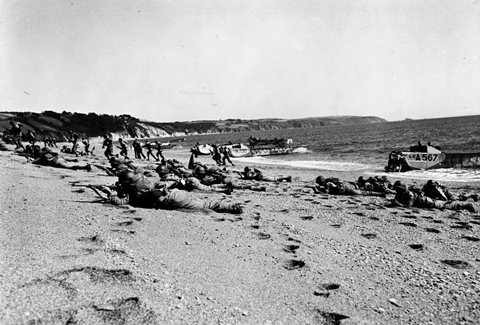
Could it have happened?
With the 70th anniversary of the D-Day invasion of France drawing near, historians will continue to debate the what-ifs of Operation Overlord, especially the events on Bloody Omaha, where poor planning, out of date intelligence, and mis-managed airstrikes nearly spelled defeat for American forces. It was the only invasion beach of five that General Omar Bradley considered withdrawing his troops from as they were held up and decimated by intense enemy fire.
But there was another beach where the American forces could have been thrown back into the sea. Utah Beach, close to the French crossroads town of Sainte-Mère-Église, could have been even worse than Bloody Omaha. And that might have caused a wholesale defeat for the Allies in France.

Utah Beach
The story behind the disaster that almost was begins seventy years ago today, on April 28, 1944. In the early morning hours before dawn, a convoy of troop transports left Plymouth, England, en route for the beach a Slapton Sands, in Lyme Bay along the southwestern coast. Code named Operation Tiger, the convoy was to participate in a simulated invasion landing. The entire area around Slapton Sands was a restricted training site, but the beach there was especially valuable for invasion training; it was practically a double for the invasion zone known as Utah Beach in Normandy. A long, flat stretch of beach with a flooded plain behind it, and narrow causeways linking it to the inland roads.
Five large transport ships, LSTs (Landing Ship, Tank), were escorted by a single Royal Navy corvette. Strung out seven hundred yards apart, they made a tempting target for the German fast attack boats. A little after two o’clock that morning, the German Schnellboote formations attacked with torpedoes. Two transports were sunk, others heavily damaged with loss of life. More than nine hundred soldiers and sailors perished in the sudden attack, many drowning in the cold Channel waters.
Unbelievably, that was not the worst of it.
The first thing that spooked the D-Day planners was the possibility that the Germans had figured out the convoy’s destination, and could thereby deduce the location of one of the landing beaches. That would mean either going in against a prepared enemy, or postponing the invasion and changing the location.
The second worry was far more troublesome. The security classification for those who knew the time, place (or both) of the Operation Overlord invasion was BIGOT. If you were a BIGOT, your movements were restricted to insure you couldn’t fall into enemy hands.
There were ten BIGOTs among the lost in the Slapton Sands convoy.
Was it possible that the Germans had picked up survivors from the transports? Could one of those survivors have been a BIGOT? The thought plagued General Eisenhower’s staff. In order to maintain secrecy, they clamped a tight lid on any news of the sinkings. Families of the dead were not notified of their death until after June 6, 1944, when they were informed their loved ones had been casualties of the invasion.
All ten BIGOTs were finally found, washed up onshore or floating in the Channel.
After the war, it turned out that the German Schnellboote captains thought they had attacked destroyers or tankers, and had no inkling of the convoy’s destination. They also prompting retreated back to Cherbourg and did not linger to pick up any survivors in the water.

The secret of D-Day had held. But in the days immediately following the sinking of the LSTs in Lyme Bay, a near panic took over the high command. This is the setting for the ninth Billy Boyle novel, The Rest Is Silence. Billy is tasked with finding the ten BIGOT bodies, a gruesome job which is made much more complex when an eleventh officer shows up among the dead; someone who was not supposed to be there.
In a final grim irony, the actual causalities at Utah Beach on June 6th were relatively light. About two hundred, compared to the nearly one thousand lost in the Slapton Sands incident. It could have been far worse.
* * *
—Learn more about James R. Benn and the Billy Boyle series, HERE.